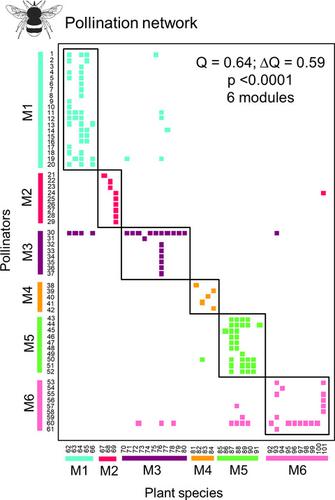当前位置:
X-MOL 学术
›
Austral Ecol.
›
论文详情
Our official English website, www.x-mol.net, welcomes your feedback! (Note: you will need to create a separate account there.)
Plant–animal interactions of understory species in an area of tropical rainforest, north‐eastern Brazil
Austral Ecology ( IF 1.5 ) Pub Date : 2021-02-05 , DOI: 10.1111/aec.13004 Leonardo Barbosa Silva 1 , Jacilene Bezerra Silva 1 , Camila Silveira Souza 2 , Murilo Menck Guimarães 2 , Margareth Ferreira Sales 1 , Cibele Cardoso Castro 3
Austral Ecology ( IF 1.5 ) Pub Date : 2021-02-05 , DOI: 10.1111/aec.13004 Leonardo Barbosa Silva 1 , Jacilene Bezerra Silva 1 , Camila Silveira Souza 2 , Murilo Menck Guimarães 2 , Margareth Ferreira Sales 1 , Cibele Cardoso Castro 3
Affiliation

|
We studied the reproductive attributes (reproductive phenology, pollination and seed dispersion) of understory woody species from a rainforest area in the Araripe‐Apodi National Forest (FLONA), NE Brazil. The FLONA has a representative number of fauna and flora species that are important for the local climatic, hydrological and ecological equilibrium of the region. The community was composed of 68 species distributed in 43 genera and 26 plant families. Melastomataceae was the family with the highest species richness. Most species (61.76%) shared floral traits that promoted bee pollination, for example white, dish type, medium‐sized flowers with pollen as the main resource. Zoochory was the most frequent dispersion system (76.47%), followed by autochory (16.17%) and anemochory (7.35%). Resource distribution (flowers and fruits) was uniform throughout the year, and pollination and dispersion networks were significantly modular, composed of five and four modules, respectively. In the pollination network, bees occurred in almost all modules, but flies, hummingbirds, butterflies and hawk moths were more restricted to certain modules, partially highlighting the idea of pollination syndromes. In the dispersion network, the modules were composed of birds from different families; only one module was comprised of all sampled mammals. Our results show that most species depend on the action of biotic vectors during their reproductive processes (pollination and dispersal). Those interactions are fundamental for maintaining biological diversity in different tropical ecosystems.
中文翻译:

巴西东北部热带雨林地区林下物种的动植物相互作用
我们研究了巴西东北部Araripe-Apodi国家森林(FLONA)雨林地区下层木本物种的生殖属性(生殖物候,授粉和种子扩散)。FLONA的动植物种类数量具有代表性,对于该地区的当地气候,水文和生态平衡非常重要。该社区由分布在43个属和26个植物科中的68个物种组成。淡色科是物种丰富度最高的科。大多数物种(61.76%)具有促进蜜蜂授粉的花卉特征,例如白色,碟形,以花粉为主要资源的中型花。Zoochory是最常见的分散系统(76.47%),其次是autochory(16.17%)和anemochory(7.35%)。全年的资源分布(花和水果)是均匀的,授粉和分散网络是显着模块化的,分别由五个和四个模块组成。在授粉网络中,几乎所有模块中都出现了蜜蜂,但蝇,蜂鸟,蝴蝶和鹰蛾更受某些模块的限制,这在一定程度上突出了授粉综合症的概念。在分散网络中,模块由不同家族的鸟类组成。所有采样的哺乳动物中只有一个模块。我们的结果表明,大多数物种在繁殖过程中(传粉和传播)取决于生物载体的作用。这些相互作用对于维持不同热带生态系统中的生物多样性至关重要。授粉和分散网络是高度模块化的,分别由五个和四个模块组成。在授粉网络中,几乎所有模块中都出现了蜜蜂,但蝇,蜂鸟,蝴蝶和鹰蛾更受某些模块的限制,这在一定程度上突出了授粉综合症的概念。在分散网络中,模块由不同家族的鸟类组成。所有采样的哺乳动物中只有一个模块。我们的结果表明,大多数物种在繁殖过程中(传粉和传播)取决于生物载体的作用。这些相互作用对于维持不同热带生态系统中的生物多样性至关重要。授粉和分散网络是高度模块化的,分别由五个和四个模块组成。在授粉网络中,几乎所有模块中都出现了蜜蜂,但蝇,蜂鸟,蝴蝶和鹰蛾更受某些模块的限制,这在一定程度上突出了授粉综合症的概念。在分散网络中,模块由不同家族的鸟类组成。所有采样的哺乳动物中只有一个模块。我们的结果表明,大多数物种在繁殖过程中(传粉和传播)取决于生物载体的作用。这些相互作用对于维持不同热带生态系统中的生物多样性至关重要。蜂鸟,蝴蝶和鹰蛾只限于某些模块,部分突出了授粉综合症的概念。在分散网络中,模块由不同家族的鸟类组成。所有采样的哺乳动物中只有一个模块。我们的结果表明,大多数物种在繁殖过程中(传粉和传播)取决于生物载体的作用。这些相互作用对于维持不同热带生态系统中的生物多样性至关重要。蜂鸟,蝴蝶和鹰蛾被更多地限制在某些模块上,部分突出了授粉综合症的概念。在分散网络中,模块由不同家族的鸟类组成。所有采样的哺乳动物中只有一个模块。我们的结果表明,大多数物种在繁殖过程中(传粉和传播)取决于生物载体的作用。这些相互作用对于维持不同热带生态系统中的生物多样性至关重要。我们的结果表明,大多数物种在繁殖过程中(传粉和传播)取决于生物载体的作用。这些相互作用对于维持不同热带生态系统中的生物多样性至关重要。我们的结果表明,大多数物种在繁殖过程中(传粉和传播)取决于生物载体的作用。这些相互作用对于维持不同热带生态系统中的生物多样性至关重要。
更新日期:2021-02-05
中文翻译:

巴西东北部热带雨林地区林下物种的动植物相互作用
我们研究了巴西东北部Araripe-Apodi国家森林(FLONA)雨林地区下层木本物种的生殖属性(生殖物候,授粉和种子扩散)。FLONA的动植物种类数量具有代表性,对于该地区的当地气候,水文和生态平衡非常重要。该社区由分布在43个属和26个植物科中的68个物种组成。淡色科是物种丰富度最高的科。大多数物种(61.76%)具有促进蜜蜂授粉的花卉特征,例如白色,碟形,以花粉为主要资源的中型花。Zoochory是最常见的分散系统(76.47%),其次是autochory(16.17%)和anemochory(7.35%)。全年的资源分布(花和水果)是均匀的,授粉和分散网络是显着模块化的,分别由五个和四个模块组成。在授粉网络中,几乎所有模块中都出现了蜜蜂,但蝇,蜂鸟,蝴蝶和鹰蛾更受某些模块的限制,这在一定程度上突出了授粉综合症的概念。在分散网络中,模块由不同家族的鸟类组成。所有采样的哺乳动物中只有一个模块。我们的结果表明,大多数物种在繁殖过程中(传粉和传播)取决于生物载体的作用。这些相互作用对于维持不同热带生态系统中的生物多样性至关重要。授粉和分散网络是高度模块化的,分别由五个和四个模块组成。在授粉网络中,几乎所有模块中都出现了蜜蜂,但蝇,蜂鸟,蝴蝶和鹰蛾更受某些模块的限制,这在一定程度上突出了授粉综合症的概念。在分散网络中,模块由不同家族的鸟类组成。所有采样的哺乳动物中只有一个模块。我们的结果表明,大多数物种在繁殖过程中(传粉和传播)取决于生物载体的作用。这些相互作用对于维持不同热带生态系统中的生物多样性至关重要。授粉和分散网络是高度模块化的,分别由五个和四个模块组成。在授粉网络中,几乎所有模块中都出现了蜜蜂,但蝇,蜂鸟,蝴蝶和鹰蛾更受某些模块的限制,这在一定程度上突出了授粉综合症的概念。在分散网络中,模块由不同家族的鸟类组成。所有采样的哺乳动物中只有一个模块。我们的结果表明,大多数物种在繁殖过程中(传粉和传播)取决于生物载体的作用。这些相互作用对于维持不同热带生态系统中的生物多样性至关重要。蜂鸟,蝴蝶和鹰蛾只限于某些模块,部分突出了授粉综合症的概念。在分散网络中,模块由不同家族的鸟类组成。所有采样的哺乳动物中只有一个模块。我们的结果表明,大多数物种在繁殖过程中(传粉和传播)取决于生物载体的作用。这些相互作用对于维持不同热带生态系统中的生物多样性至关重要。蜂鸟,蝴蝶和鹰蛾被更多地限制在某些模块上,部分突出了授粉综合症的概念。在分散网络中,模块由不同家族的鸟类组成。所有采样的哺乳动物中只有一个模块。我们的结果表明,大多数物种在繁殖过程中(传粉和传播)取决于生物载体的作用。这些相互作用对于维持不同热带生态系统中的生物多样性至关重要。我们的结果表明,大多数物种在繁殖过程中(传粉和传播)取决于生物载体的作用。这些相互作用对于维持不同热带生态系统中的生物多样性至关重要。我们的结果表明,大多数物种在繁殖过程中(传粉和传播)取决于生物载体的作用。这些相互作用对于维持不同热带生态系统中的生物多样性至关重要。


























 京公网安备 11010802027423号
京公网安备 11010802027423号